Bergenias - they're great for shady spots.
Bergenias are a low-growing, hardy perennial which will grow happily in a shady spot, such as under trees in the garden. Once established, they will tolerate dry times. Give them some love and they will look much better and reward you with more flowers. The flowers mostly come in shades of Pink, but they are also available in white, mauve and red. The shiny leathery leaves are also attractive, and the plants Common name, "pigsqueak" comes from the fact that if you rub together the wet leaves, they squeak. These plants are apparently deer and rabbit resistant, and are virtually pest free.
Bergenias are common in Sydney gardens, usually used in rockeries or as a border plant. They are considered more of an old fashoined plant, so may be hard to find in Nurseries, but they are easily propagated. Take cuttings from the thick stems in warmer months, or just divide the clumps. They will grow in a wide array of climates from cooler to warmer. I took these photos locally close to Sydney Harbour.
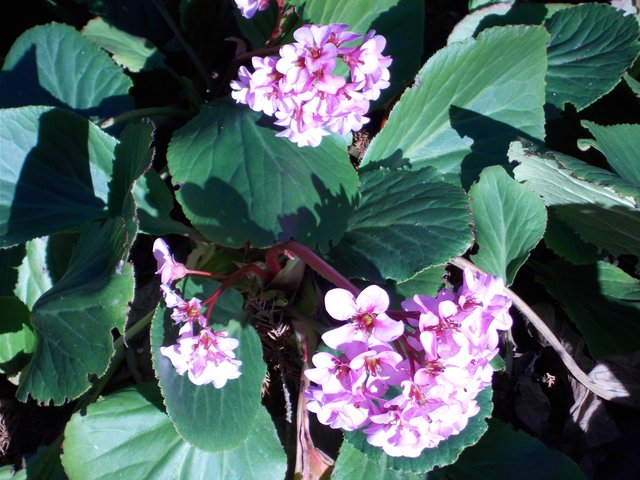
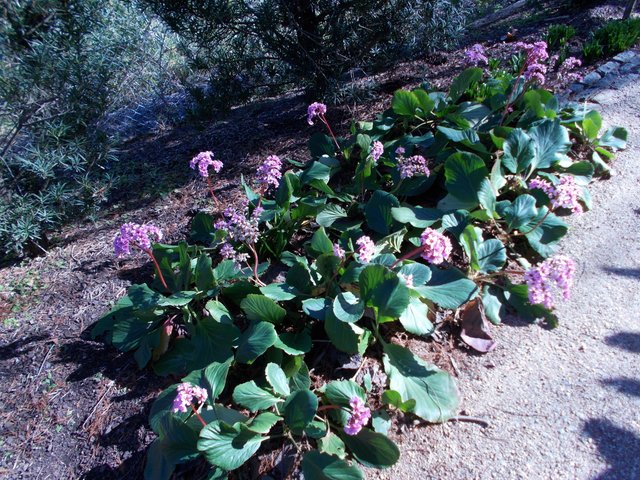
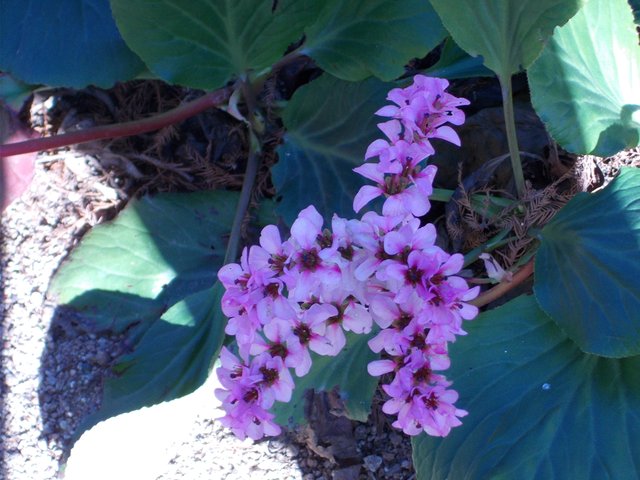
Bergenia
are incredibly sturdy plants, and some varieties will grow in temperatures from -35F to 115F. They are unfussy about soil and will tolerate nearly any soil condition as long as it has decent drainage. The leaves stay a glossy green color most of the year, except in cooler climates, where the color may change to bronze or red in winter.
The flowers arise gracefully on stems which resemble rhubarb stalks; the flowers range from fuchsia to bubblegum, to pinkish white, and they are said to attract hummingbirds, which isn’t surprising given the color and shape of the blooms.
Bergenia Cordifolia
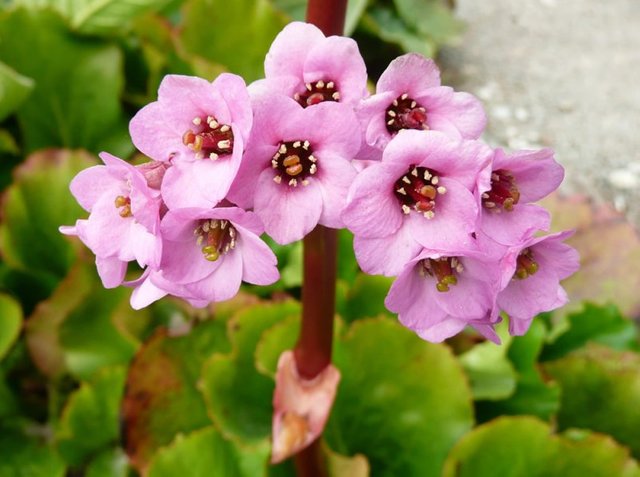
Source
Bergenia is commonly called “pigsqueak” because of the sound it makes when two leaves are rubbed together. In recent years, many new varieties have emerged from breeders who’ve attempted to create different colors of bloom, more petite sizes which fit more easily between shrubs, and plants with a clumping habit which are less likely to flop or become leggy.
Source
Source
Source
Source
Text Source
Fav. comment Award ! Thanks for your great Pics selection and info !
Amazing! Thank you!
Bergenia
Bergenia have tough, thick rhizomes with leathery, glossy green rosettes—with autumn color—of alternate, simple, obovate leaves. Blooms are produced in loose clusters in spring. Grow in a woodland garden or use as a groundcover.
Noteworthy Characteristics
Thick rhizomes and distinctive rosettes of leathery leaves topped with pink-red flowers on fleshy red or purple stalks.
Care
Grow in rich, moist soil in sun to part shade. Dislikes extremes of heat or drought, but will tolerate poor soil. Mulch in autumn to protect early spring flowers from frost.
Propagation
Divide clumps or root rhizomes in spring or autumn every 3 to 5 years. Root young rhizomes in sand or in soil.
Problems
Sometimes affected by fungal leaf spot and rhizome rot. Weevils, slugs, snails, caterpillars, and foliar nematodes.
https://www.finegardening.com/genus/bergenia
Fav. comment Award ! I like your pic selections and information. Well done !
Bergenia cordifolia is a vigorous and low-growing perennial that forms neat mounds of leathery, dark green foliage that grows just 6 inches high. Very durable and slow spreading. For these reasons, it is well suited for use as a general ground cover or facing plant for small to moderate sized areas, particularly in locations where its splendid foliage and interesting flowers will be visible to passersby.
Bergenia has thick, leathery, shiny, evergreen leaves that are not only large, they are colored a very deep shade of green and are often used in floral arrangements. Bergenia perform happily in any well-drained, slightly acidic to slightly alkaline soil. They tolerate short periods of drought, yet perform best if the soil is kept moderately moist. Thrive in full sun to light shade. One of the truly great ground covers that can be grown from flower seeds.
Resources
Silly Sausage Award. Your great pics selection and information make a great comment.
Thank you so much @ctrl-alt-nwo!
I can see that you really love nature very much. Most of your posts are about the lovely nature and plants. If you do post informational articles about plants, you can also use the tag steemiteducation since they are educational for knowledge of different plants.

I took a walk at the park yesterday and took some pictures of flowers too using my new phone Samsung S8.
Just a thought. I will be great for you to insert your username to your photographs if you have the time since they are taken by you.
Thanks for your regular enriching sharing of nature!
Growing Bergenia loves shade and dappled sunlight, so choose a darker corner of the yard or a bed up against the house that rarely gets full sunlight. Plant them 12 to 18 inches apart early in the spring to fill the area without crowding them out.
Choose a spot with well-drained, moist soil, and add compost to the bed as needed. Watch for flowers in the early spring. Bergenia will grow a spike from 12 to 16 inches tall, and the tiny, bell-shaped blooms will cover the spikes in pink, white or purple flowers. These flowers remain for a number of weeks, then begin to die off. Deadhead the spent blooms by snipping off the spikes once the flowers brown and begin to fall off.
Bergenia is a slow grower, and only needs dividing once every three to five years. Once the center of the clump dies off and is empty, divide the plant into four pieces and plant each one separately. Water the new plants thoroughly when you set them out, and only when the weather is particularly dry after that.
Source
@ctrl-alt-nwo

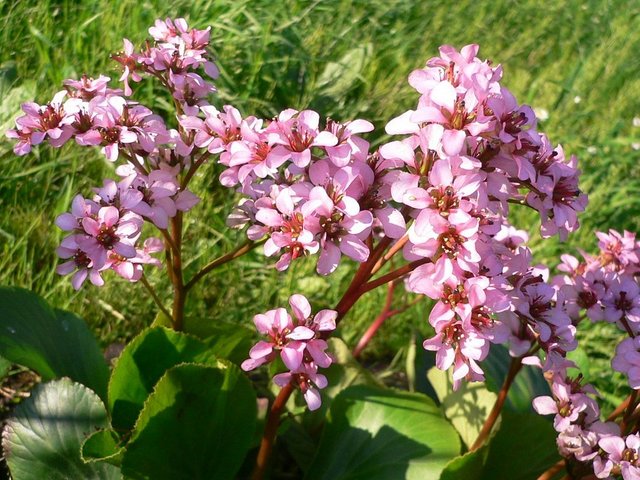
This is really garden. that is great information and fantastic.
Hi @ctrl-alt-nwo, That's pretty beautiful flowers indeed smallest adorable plants. I prefer to growth up my garden. Growing like bunches of plants. Well description by you. Hope to add more..
Bergenias are perennial, semi-evergreen plants which originated in central Asia.
The Bergenia has been cultivated in home gardens since the early part of the nineteenth century. In the past hundred years or so botanists have created many new hybrid cultivars of this plant. Unfortunately, this very worthwhile plant seems to be overlooked by many gardeners as they make their garden plans.
The large, leathery leaves of the Bergenia plant resemble a heart, with saw-toothed or wavy edges. For most of the year these leaves will remain a glossy green, but in colder climates the foliage will take on a beautiful red or bronze coloring in the fall.
The small, bell-shaped flowers are produced in compact clusters atop twelve inch burgundy stems in the early spring. Bergenia flower colors range from the palest pinks (almost white) to ruby red or dark purple. Each flower spike usually only lasts for a few weeks, but the blooming period can be prolonged by removing the spent spikes regularly.
Thank you....
Images from google
Source: http://www.thegardenhelper.com/bergenia.html
OMG. Beautiful flowers I like it , flowers of this time, it brightens like this, some say to us, flowers help to maintain our natural beauty, flowers are used in many of our work, but flowers are not always available at all, most flowers, Found in the flower season, do you think, when we see more flowers than ever
Yep..I think as you asked.
Well said @milanm
@madushanka hello 👋 sir, Of course it is true that flowers help maintain our natural beauty. Flowers help to purify the human mind. When we see flowers, a passion is created in our mind, what do you say?
Oh yeah, great flower, my friend @ctrl-alt-nwo!
The botanical name, Bergenia, was in honor of a German botanist and physician, Karl August von Bergen. The common name of ‘pigsqueak’ is derived from the sound you can make if you rub two of the leaves together! This plant is native to Central Asia, and is related to Mukdenia and Rodgersia
Bergenia enjoys partial shade to full sun in cooler climates – very hot sun can burn them, so they are best shaded in hot areas. They also would benefit from a protective, light winter mulch in very cold areas, and windbreaks (rocks, shrubs, etc) in areas with very cold winter winds. These plants prefer moist, rich humus soil, and can be slow-growing if water is restricted and they get too dry. Bergenia can experience center die-out and can be divided in the spring, after flowering.
This plant is pretty disease and pest resistant, the only pest known to show up are vine weevil adult beetles, who will occasionally eat the edges of leaves, leaving them ‘notched’ around the rims. This doesn’t do any significant damage to the plant, however. You can use commercial or homemade insecticides, or simply pick off and destroy any vine weevils you find on the plant. Bergenia is both deer and rabbit-resistant; they prefer not to eat it.
https://learn.hostasdirect.com/bergenia-information/
Thank you @ctrl-alt-nwo ! Interesting article. I wonder why this deer does not like deer, rabbits and other potential enemies? Is it poisonous? I see that this plant is used for medical purposes.
My guess is that the leaves are too tough and leathery to eat easily.
Not a poisonous plant, that's for sure. I found information that a drink was made from it, like tea. And this is a medicinal plant. But, there are contraindications.